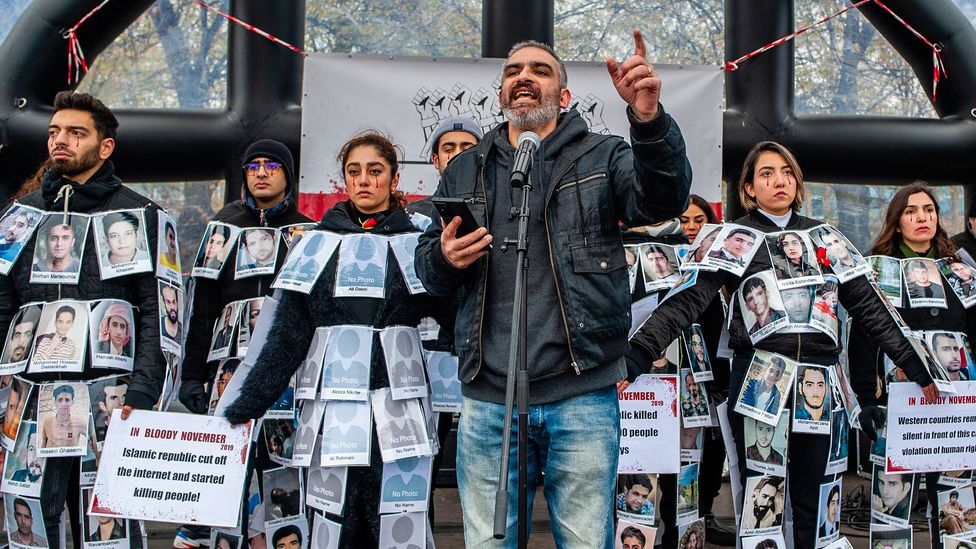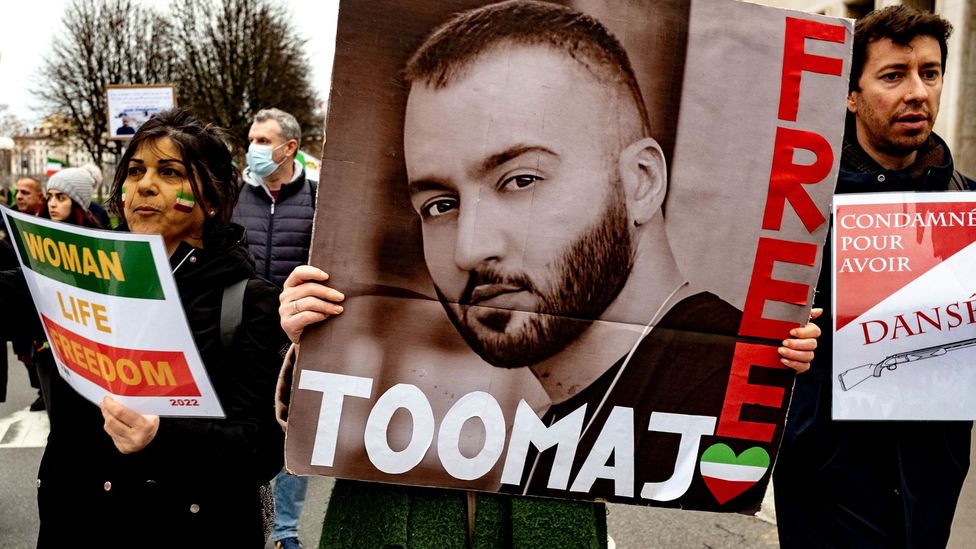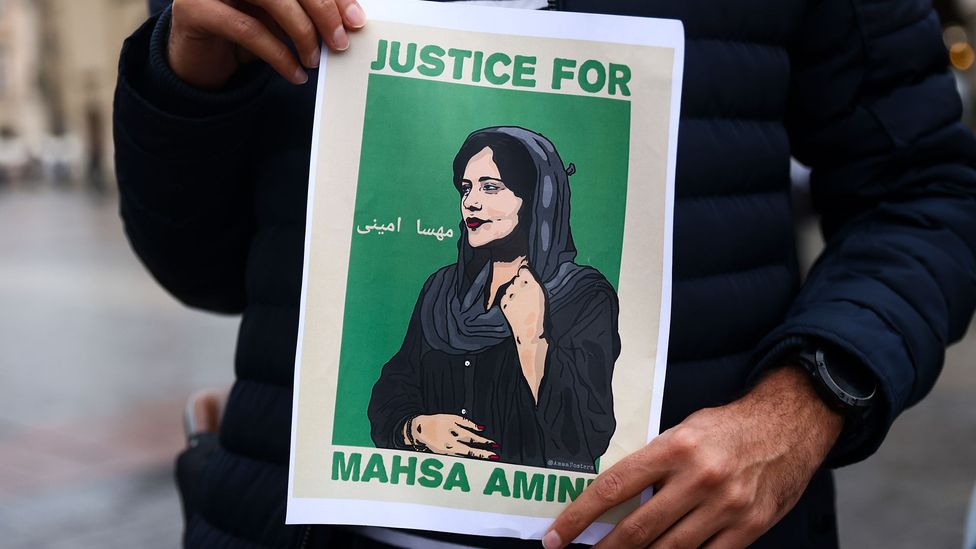The Iranian songs that became anthems

In the early-to-mid 2000’s, Soroush Lashkari, better known as Hichkas (the Persian word for “nobody”) was recording grainy rap videos on the streets of Tehran. Since he didn’t have any lighting at night, he and his friends would shoot their videos by walking in front of the tail-lights of a car driving in reverse. As hip-hop is a largely illegal genre of music in Iran, he would sell his work covertly, through personal emails, attempting to screen out undercover government agents by calling buyers first and delivering CDs to their door. Despite the government branding hip-hop as “Satanism”, Iranian rap spread via the internet and grew over the following decade to become one of the most popular genres of music among the country’s youth, with Hichkas considered its pioneer.
More like this:
– The song expressing a nation’s defiance
– The song that changed the US
– The love song that became an anthem
In her book Soundtrack of the Revolution, which examines how music and politics are intertwined in Iran, Nahid Siamdoust argues that the popularity of hip-hop in Iran can be linked to its connection with Iran’s centuries-old poetry tradition, and rap’s power of personal expression lends itself to critique and protest. Not all Iranian rap is tied directly to resistance and politics: there are lighter-themed subcategories that focus on social issues, rather than direct political critique. Today, however, as the ongoing Woman, Life, Freedom movement in Iran has heightened political tensions to a level not seen in decades, the messaging in Iranian hip-hop has become increasingly radical and rappers themselves have become some of the most celebrated and loudest political voices in the movement.
Born in Tehran in 1985, Hichkas’s early socially critical work gave an insight into life in Iran, particularly of the young men of lower middle-class and middle-class backgrounds affected by devastating unemployment and a spiralling currency. With a socially realist tone, he addressed topics like poverty, corruption, inequality and oppression in the Islamic Republic era. When I first visited Iran in 2016 as a diaspora Iranian, young Iranians would play the music on their phone and recite Hichkas’s lyrics as a way of teaching me about how they were really living.

Hichkas is considered the pioneer of contemporary Iranian rap, which has grown to become one of the most popular genres of music among the country’s youth (Credit: Getty Images)
Another recurring theme in Hichkas’s work has been the increasing censorship of artistic expression in Iran, where artists are required permits under the narrow rules of the Ministry of Culture and Islamic Guidance, which ensure that cultural works are inoffensive in the eyes of the clerical establishment. Shining a light on the impossibility of creative freedom under censorship, Hichkas asked whether Iran’s revered literary works would have come to life under these conditions: “What if Hafez for his Divan, what if Rumi for his Masnavi and Muhammad for his Quran had to receive government publication permits?”
A good day will come?
Hichkas’s perennial collaborator under the pioneering Moltafet label, the producer Mahdyar Aghajani, has been central to the development of the Iranian hip-hop sound. In its early days, Iranian hip-hop artists rapped in English and were heavily inspired by US rap in their appearance and musical expression. Aghajani, who had classical music training, sought to create a distinctly Iranian sound by using traditional Persian instruments like the tar, a long-necked lute and the ney, a type of flute, and Hichkas’s key lyrics were written in Persian instead of English. Despite initial inspiration from and imitation of Western rap, Iranian rappers created a distinct identity, as expressed by the popular rapper Yas in 2014: “Poetry is in our blood. If [Tupac] could sing about his life and pain and his culture, why couldn’t I do the same thing in my own language?”
In 2010, Hichkas released a wistful, longing anthem called A Good Day Will Come, shortly after millions took to the streets as part of the Green Movement to protest an election result they believed to be rigged, and to demand political and civil freedoms. In the song, Hichkas expressed his hope for a day where Iran would be free from violence and chaos. However, the tension following the protests forced Hichkas’s exile to London, and the track became his last to be recorded inside Iran (it was released while he flying out of the country). The song became iconic to many young people (the slogan A Good Day Will Come is still graffitied by youngsters on the walls of Tehran). Meanwhile, the movement was brutally squashed and its leaders systematically arrested by the government, and the “good day”, for many, has still yet to be seen.
“Rap’s history and legacy in post-revolutionary Iran is in and of itself, really political”, Nahid Siamdoust, associate professor in media and Middle Eastern studies at the University of Texas at Austin, tells BBC Culture. “There wasn’t a whole lot of leeway for musicians or other creators of cultural content to express that kind of critique. Hip-hop and rap provided that space.” According to Siamdoust, the period following the Green Movement gradually led to the increased silencing of rappers, which made it difficult for any kind of political expression to come through.
“When I became a teenager and started producing for underground artists, the Iranian government started cracking down on us, closing the studios we used and arresting the studio staff as well as arresting the artists I was working with,” Mahdyar Aghajani told The Quietus in 2017. Aghajani, who was exiled to Paris, told The Quietus that underground artists were treated as “national security” cases. For domestic Iranian rappers, particularly those who incorporated political subjects into their work, their first track might very well be their last, due to pressure from the authorities.
During the 2010s, there were some attempts to co-opt hip-hop as a pro-establishment art form, with the aim of promoting Islamic values and themes to a younger demographic. The tattooed rapper Amir Tataloo’s support for the conservative cleric Ebrahim Raisi’s presidential run in 2017 was the most notable of these.
An era of protest
In the late 2010s, political tensions started rising again, with protests emerging annually between 2017 and 2019. Calls for regime change grew in strength, particularly among an increasingly vocal younger generation. The 2019 protests were a catalyst for lasting resentment against the state, as security forces killed between 300 in some reports and up to 1500 protestors, according to Reuters, within a week.
Addressing the protests, Hichkas released They’ve Clenched Their Fists in 2019; on the record’s cover was a long list of names of people who had been killed during the crackdown. Spoken word more than rap, the track was a searing critique of worsening conditions in Iran to the tune of a sombre setar (Iranian lute)melody. “They don’t want citizens, they want slaves. They turned the whole country into a big cage and say that there are no prisoners.” It concluded with harrowing audio of protesters being shot at.
In 2021, Toomaj Salehi, a Bakhtiari rapper who works by day as a metal factory worker, emerged as the embodiment of a defiant, fed-up generation. Typically rapping barefooted, he announced himself in his lyrics as the “roar of a rage” and a “soldier for rights”. The track Normal from 2021, made a mockery of any notion of normality in a country with staggering economic inequality. Rat Hole, released the same year, took aim at individuals domestically and abroad who he accused of being complicit in allowing human rights violations to rage in the country by looking the other way.

The rapper Toomaj Salehi, who emerged as the embodiment of a defiant generation, was arrested in 2022 and charged with “corruption on Earth” (Credit: Getty Images)
“It was truly astounding what he was willing to express in his music, because of the silencing of this underground music scene, because of the securitisation of the internet,” says Siamdoust. Aware of how the internet had become a threat to their stability, the regime ramped up internet outages and surveillance of individuals online. Salehi was duly arrested for “spreading propaganda against the state”, but was later released.
Saman Yasin, a Kurdish rapper, also displayed courageous outspokenness, and his tenacity was only amplified by the fact Kurds face the brunt of repression and marginalisation in Iran. In the song Haji, recorded and released in 2022, he rapped: “They banned my happiness. They turned me upside down like an animal. No, I won’t be silent. […] I am wounded in an unequal war. I’m a revolutionary, but an advocate for peace.”
A turning point?
The aforementioned women-led, Woman, Life, Freedom movement, which arose in September 2022 following the death in custody of the young Kurdish woman, Mahsa Amini, proved to be a social, cultural and political turning point. Hichkas, who had long been assumed to have withdrawn into retirement, released This One Is For, a hip-hop spinoff of the Grammy-winning anthem to the movements, Baraye by Shervin Hajipour (which won the first Grammy Award for Best Song for Social Change in February 2023). While Hajipour listed the ills of Iranian society and the collective desires for a better future, Hichkas instead took visceral, rage-fuelled aim at the state. Discarding the wishful mantra of “A good day will come”, Hichkas instead raps: “We will be bringing a good day“, illustrating how the Iranian zeitgeist has changed over the last decade. Between soundbites of protesters chanting, Hichkas raps: “This one is for the forced poverty, the natural disasters, for every kind of discrimination that you can think of […] Mark my words, victory is ours, we are not dead yet.” The song received millions of plays on Soundcloud.
In March 2023, Fadaei, rapper under the Moltafet label, released Meshki (Black), a track harnessing the trademark mocking tone of the label’s recent output. Parodying the Shia Islamic tradition of Maddahi, a ceremonial style of religious singing used in funerals and other events, Fadaei sarcastically mourns the death of the Islamic Republic by repeated warnings against the clergy, warning them that this is the end of the line for them.
The Iran-based rappers Toomaj Salehi and Saman Yasin also joined the recent Woman, Life, Freedom protests, at great risk to their safety. “Someone like [Saman] Yasin and Toomaj are actually enacting a political idea that makes them even more influential to the people who know them. Being a part of the movement, being on the street, and enacting their idea on top of being a rapper makes them a threat to the Islamic regime, and also a kind of a heroic icon for people,” Elham Golpushnezhad, a lecturer in cultural studies at the SAE Institute in Brisbane, tells BBC Culture. Golpushnezhad explains that the movement effectively ended the state’s attempt to co-opt hip-hop for their own purposes. “They were not successful and the most important reason for that is Woman, Life, Freedom,” she says.

The Woman, Life, Freedom movement arose in September 2022 following the death in custody of the young Kurdish woman, Mahsa Amini (Credit: Beata Zawrzel/NurPhoto via Getty Images)
In October 2022, Salehi and Yasin were arrested on charges of “corruption on Earth” and “waging war against god” respectively, which put them at risk of receiving the death penalty. Salehi has reportedly been beaten and been held in solitary confinement. Yasin was sentenced to death, before winning an appeal to have the verdict overturned, but remains in prison; his trial is due to take place on 8 May. Two days before his arrest, CBC, the Canadian public broadcaster, released an interview with Toomaj. “I’m worried that if I’m arrested, a portion of the protesters could become hopeless and upset. Because right now, we don’t have time for grief. If my loved ones next to me are killed – I shouldn’t cry. I have to get angry,” he said, in what proved to be some of his final public words before his detention.
With the protests showing the outsized potential of rappers to become celebrated by anti-government movements, the regime has become more vigilant and tightened restrictions on hip-hop. As banners supporting Toomaj regularly hang illicitly under bridges across Tehran, it is unclear whether the red line that rappers like he and Yasin have crossed will be drawn back by the government in order to silence dissent. As Afrasiab, a rapper-activist and friend of Toomaj, put it in a recent video message: “Do you know what they fear the most? That we are not afraid anymore.”
If you would like to comment on this story or anything else you have seen on BBC Culture, head over to our Facebook page or message us on Twitter.
And if you liked this story, sign up for the weekly bbc.com features newsletter, called The Essential List. A handpicked selection of stories from BBC Future, Culture, Worklife and Travel, delivered to your inbox every Friday.








